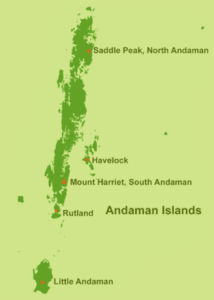In news– Recently, the Union government rechristened Mount Harriet, a historical tourist spot in the Andaman and Nicobar islands, as ‘Mount Manipur’ recognizing Manipur’s role in the historic 1891 Anglo-Manipur war.
Anglo-Manipur war of 1891-
- The War was fought between the kingdom of Manipur and the British over a month in 1891.
- The British government took advantage of the “internal dissension” among the princes of the royal family.
- This aggressive imposition of British law in a sovereign state was rejected by the king, precipitating the Anglo-Manipuri War of 1891.
- In the first phase of the war, the British surrendered and their officers — including Quinton — were executed in public.
- In the second phase, the British attacked Manipur from three sides, and finally captured the Kangla Fort in Imphal.
- Prince Tikendrajit and four others were hanged by the British, while Kulachandra, along with 22 others, were banished to the Andaman Islands.
- Since the cellular jail (Kalapani) was yet to be built, Kulachandra and the prisoners were kept on Mount Harriet, a hillock in what is now the Ferragunj tehsil of South Andaman district.
- 23 men, including King Kulachandra and his brothers, were “transported for life” to the Andamans.
- The 23 are considered war heroes in Manipur and hence Mount Harriet is an important symbol of the Anglo-Manipur War of 1891.
- In India, the war was viewed as being part of the general uprising against British rule in the country, soon after the Revolt of 1857.
- The war led to Manipur officially becoming a princely state under the indirect rule of the British crown.
Evolution of the name Mount Harriet-
- Mount Harriet is the third highest peak (383 metres (1,257 ft) in the Andaman and Nicobar Islands, next to Saddle Peak (732 metres (2,402 ft)) in North Andaman and Mount Thuillier (568 metres (1,864 ft)) in Great Nicobar.
- It served as the summer headquarters of the Chief Commissioner during the British Raj.
- It is believed to be named after British artist and photographer Harriet Christina Tytler, who was the wife of Robert Christopher Tytler, a soldier who served in the British Indian Army.
- Between 1862 and 1864, Tytler was the superintendent of the penal colony at Port Blair.
- Harriet is remembered for her work in documenting the monuments of Delhi and for her notes at the time of the Revolt of 1857 in India.
- Close by is the Mount Harriet National Park known for its wide variety of birds.

Mount Harriet National Park-
- The park was established in 1969.
- The park’s well-known faunal species are Andaman wild pigs (an endangered species), saltwater crocodiles, turtles and robber crabs.
- The park is also a butterfly hotspot.
- A notable feature 2 kilometres (1.2 mi) away from the park is Kalapathar, where prisoners used to be pushed down the ravine to their death.
- The tribal community living in the tropical forest of the park are the Negrito people, who are hunter-gatherers.
















